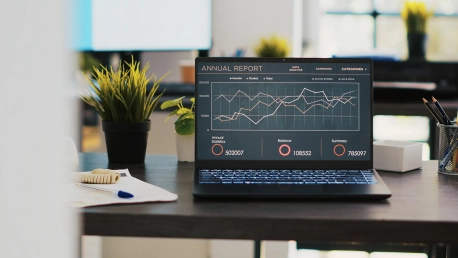In an age where data reigns supreme, small and medium-sized businesses (SMBs) are tapping into Real-Time Business Intelligence (BI) to carve out their niche in competitive markets. Real-Time BI is revolutionizing the way SMBs operate, providing instant analytical insights that drive quick, impactful decision-making. By harnessing this power, these nimble enterprises are not only staying afloat but also setting sail toward unprecedented success.
1. Establish Specific Goals
Before jumping on the BI bandwagon, it’s vital that SMBs spell out their Real-Time BI goals. Are they in pursuit of enhanced customer satisfaction, streamlined operational efficiency, or perhaps a spike in sales? By setting concrete targets, such as reducing decision-making time by half or boosting customer retention by a set percentage, SMBs can tailor their BI strategy to directly impact these objectives. This crucial first step ensures the BI system developed is not just a shiny new toy but a tool honed to solve real business challenges.To ensure target precision, SMBs should dissect their workflows, identify pain points, and zoom in on the metrics that matter most. Whether it’s accelerating the supply chain, fine-tuning marketing efforts, or better managing human resources, Real-Time BI can provide a magnifying glass to spot opportunities for optimization.
2. Select Appropriate Tools
Navigating the sea of Real-Time BI tools can be daunting for SMBs. The key is to anchor down tools that dovetail with the company’s goals, size, and budget. Microsoft Power BI, Tableau, and Looker stand out as beacons in the cloud-based BI space, offering potent analytics without a hefty upfront investment. When selecting these tools, businesses should weigh factors like integration capabilities, user-friendliness, and scalability.The quest for the right BI tool is akin to choosing a trusty vessel for open waters. It must be robust enough to weather data storms, agile enough to navigate through complex analyses, and scalable to grow with the company. By vetting each tool against these criteria, SMBs can confidently set sail with a BI solution that brings them closer to their treasure trove of business objectives.
3. Guarantee Data Integrity
The course to actionable insights is charted with quality data. SMBs must set sail with rigorous data cleansing procedures, ensuring accuracy and standardization. This is the compass that will guide companies through treacherous seas of misinformation and misinterpretation. It’s essential to regularly scrub the data deck, removing inaccuracies and aligning datasets to ensure they are of the highest navigational quality.Investments in data quality tools and strategies are not mere overhead but an assurance policy for Real-Time BI endeavors. They prevent SMBs from veering off course due to erroneous data, ensuring that every strategic decision made is based on a true North of reliable information.
4. Allocate Resources for Infrastructure
Sturdy Real-Time BI infrastructure is the keel that keeps the SMB’s ship stable amidst the waves of rapid data analysis. However, investing in servers and storage might weigh heavy on an SMB’s financial hull. This is where cloud computing platforms come to the rescue, offering scalable resources that can be adjusted to the shifting tides of data needs and opportunities.As they move away from heavy capital expenditure, SMBs can steer toward operational expenses with flexible cloud services. These offerings not only provide the necessary technology to harness the power of real-time data but also free up resources to invest in innovation and growth.
5. Educate Staff Members
Crew training is indispensable; a ship is only as good as its sailors. Hence, SMBs must invest in comprehensive training for their crew to navigate the Real-Time BI seas. Through workshops, digital tutorials, and hands-on sessions, employees become adept at using BI tools, interpreting data charts, and understanding the analytics sextant. This education turns raw data into navigable insights.The emphasis on training promotes a data-driven culture within the company. When every team member understands how to use the BI system, decision-making becomes more democratic, inviting a variety of perspectives and experiences to the business table.
6. Pilot with a Narrow Scope and Expand Gradually
Starting with a concise, manageable project is akin to navigating a small bay before heading into the open ocean. This approach allows SMBs to adapt to the BI ecosystem gradually, testing waters with the tools, aligning strategies, and ensuring their business model aligns with the analytical insights gained. Once the smaller project proves successful, the SMB can confidently expand the BI system’s reach.Expansion should be guided by both the initial successes and the evolving business landscape. As new business currents emerge, so too should the Real-Time BI efforts grow, always staying one step ahead of the competition.
7. Conduct Regular Reviews and Refinements
In today’s data-driven era, small to midsize businesses (SMBs) are leveraging the power of Real-Time Business Intelligence (BI) to gain a foothold in the fiercely competitive marketplace. This cutting-edge BI is a game-changer, delivering on-the-fly insights that enable SMBs to make swift, effective decisions. With real-time data analysis at their fingertips, these agile companies aren’t just surviving; they’re navigating toward success with newfound momentum.Real-Time BI transforms data into actionable business strategies, giving SMBs the visibility to respond to market dynamics instantly. This immediacy is invaluable, as it allows for adjustments to be made on the fly, ensuring these businesses remain dynamic and competitive. Unlike larger corporations that may be bogged down by complex data infrastructures, SMBs enjoy the advantage of agility, making real-time insight integration a smoother and more beneficial process.Thanks to Real-Time BI, SMBs now have the capabilities that were once the exclusive domain of larger organizations. This technology empowers them with the ability to scrutinize market trends, consumer behavior, and operational efficiencies without delay. It’s this quick access to critical business metrics that facilitates informed, timely decision-making—a key ingredient in the recipe for a thriving, successful business venture in the modern commercial landscape.









